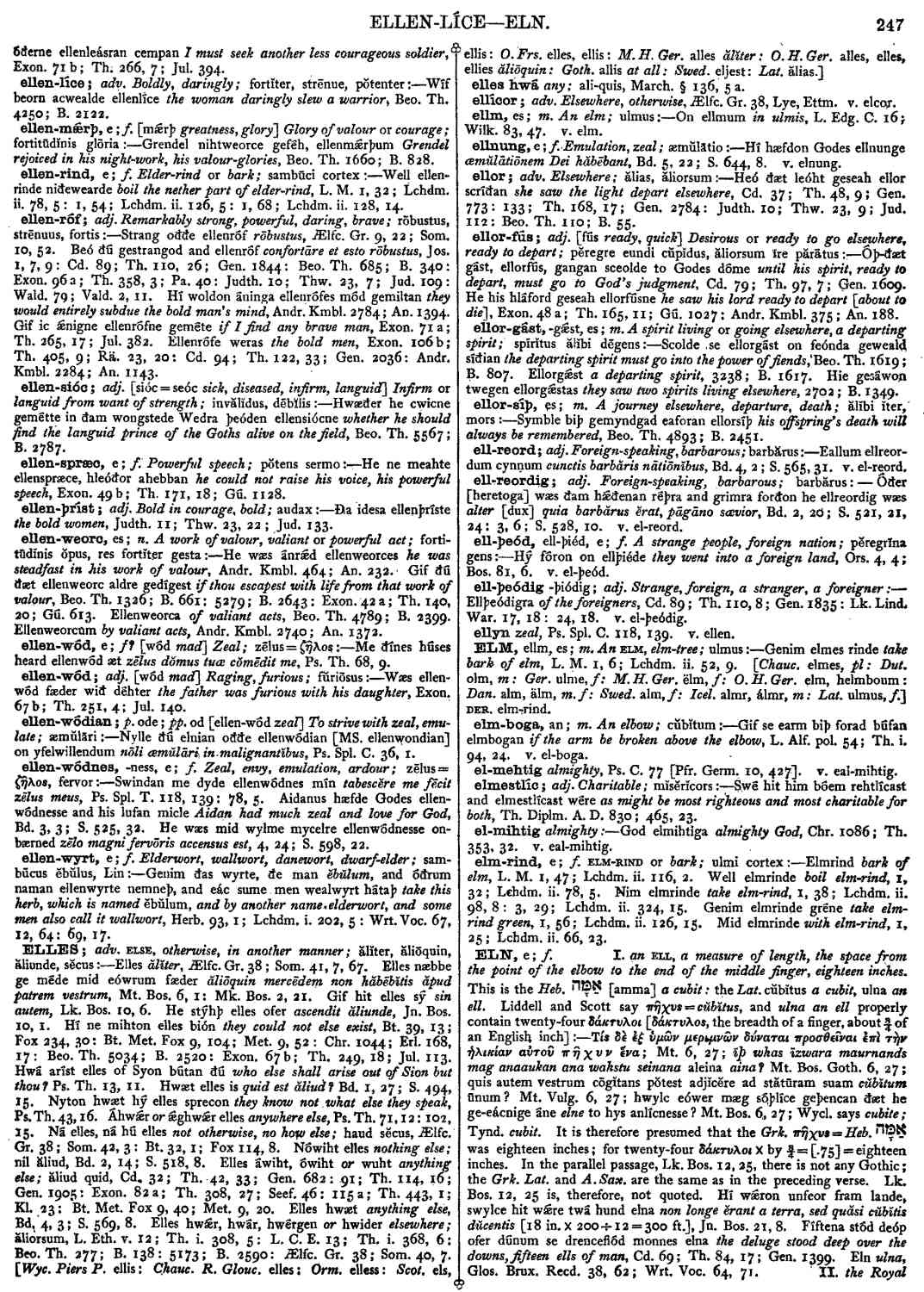ELN
- noun [ feminine ]
-
Τίς δὲ ἐξ ὑμῶν μεριμνῶν δύναται προσθεῖναι ἐπὶ τὴν ἡλικίαν αὐτοῦ πῆχυν ἕνα; Mt. 6,
- 27; īp whas īzwara maurnands mag anaaukan ana wahstu seinana aleina aina? Mt. Bos. Goth. 6, 27; quis autem vestrum cōgĭtans pŏtest adjĭcĕre ad stătūram suam cŭbĭtum ūnum? Mt. Vulg. 6, 27; hwylc eówer mæg sóþlíce geþencan ðæt he ge-eácnige áne elne to hys anlícnesse? Mt. Bos. 6, 27; Wycl. says cubite; Tynd. cubit. It is therefore presumed that the Grk. πῆχυς = Heb. HEBREW was
non longe ĕrant a terra, sed quăsi cŭbĭtis dŭcentis
[18 in. × 200 ÷ 12 = 300 ft.], Jn. Bos. 21, 8. -
Fíftena stód deóp ofer dúnum se drenceflód monnes elna
the deluge stood deep over the downs, fifteen ells of man,
- Cd. 69 ;
- Th. 84, 17;
- Gen. 1399 .
-
Eln
ulna,
- Glos. Brux. Recd. 38, 62;
- Wrt. Voc. 64, 71.
-
Se weall Babilónes is fíftig elna brád, and twá hund elna heáh ... and ymbútan ðone weall is se mǽsta díc ... and wiðútan ðani díce is geworht twegra elna heáh weall
the wall of Babylon is fifty ells broad, and two hundred ells high ... and round the wall is a very great dike ... and outside the dike a wall is built two ells high,
- Ors. 2, 4;
- Bos. 44, 23-28.
-
Se hwæl biþ micle læssa ðonne óðre hwalas: ne biþ he lengra ðonne syfan elna lang; ac, on his ágnum lande, ða beóþ eahta and feówertiges elna lange, and ða mǽstan, fíftiges elna lange; ðara, he sǽde, ðæt he syxa sum ofslóge syxtig on twám dagum
this whale is much less than other whales: it is not longer than seven ells; but, in his own country [Norway], they are eight and forty ells long, and the largest, fifty ells long; of these, he said, that he was one of six, who killed sixty in two days.
- Ors. 1, 1;
- Bos. 20, 18-23.
-
In giving the size of the Horse-whale or Walrus, and of the Whale, Ohthere, a Norwegian, would most probably calculate by the measure of Scandinavia, the ell of Norway, Sweden, and Denmark. Molbeck, in his Dansk Ordbog, thus defines it 'Alen, et vist længdemaal, som deles i 24 tommer ... Tomme een 12te fod, og een 24de alen,' ... That is,
Ell, a certain measure of length, which is divided into 24 inches ... An inch one 12th of a foot, and one 24th of an ell.
King Alfred, in his Anglo-Saxon version of Orosius, followed the calculation of Ohthere, who says that the Horse-whale or Walrus is 7 ells long, that is 14 feet, and the Whales 48 ells, and the largest 50, that is 96 feet, and the largest 100 feet long. These calculations approach very nearly to those given by Mr. Broderip, who says the length of the Walrus is from 10 to 15 feet, and Dr. Scoresby, who gives the lengen of the Physalus to be about 100 feet, Ors. Eng. p. 43, note 45.
-
The Flemish ell is 3 quarters of a yard or 27 inches; the English 5 quarters or 45 inches; and the French 6 quarters or 54 inches. [Early English, Wrt. spec. 35, án elne long: R. Glouc. 429, 3, elnen, pl: Plat. eel, f: Frs. jelne; O. Frs. ielne, elne, f: Dut. el, elle, f: Ger. elle, f: M. H. Ger. elne, eln, elline, ellen, f: O. H. Ger. elina, elna, elle, f: Goth. aleina, f: Dan. alen, f: Swed. aln, f: Icel. alin, f: Lat. ulna. f: Grk. ὠλένη, f. Eln the ell is found in A. Sax. eln-boga, el-boga the elbow: Dut. elle-boog:
Ger.
ellen-boge.] Ell is an old Teutonic word being used in the oldest German, the Gothic translation of Ulphilas about A. D. 360: in Anglo-Saxon about 895. - The date of its use in other parts of Europe may be ascertained by referring to the languages quoted above, and in the list of contractions where the names and dates of the authors are given.
Bosworth, Joseph. “ELN.” In An Anglo-Saxon Dictionary Online, edited by Thomas Northcote Toller, Christ Sean, and Ondřej Tichy. Prague: Faculty of Arts, Charles University, 2014. https://bosworthtoller.com/9274.
Checked: 1